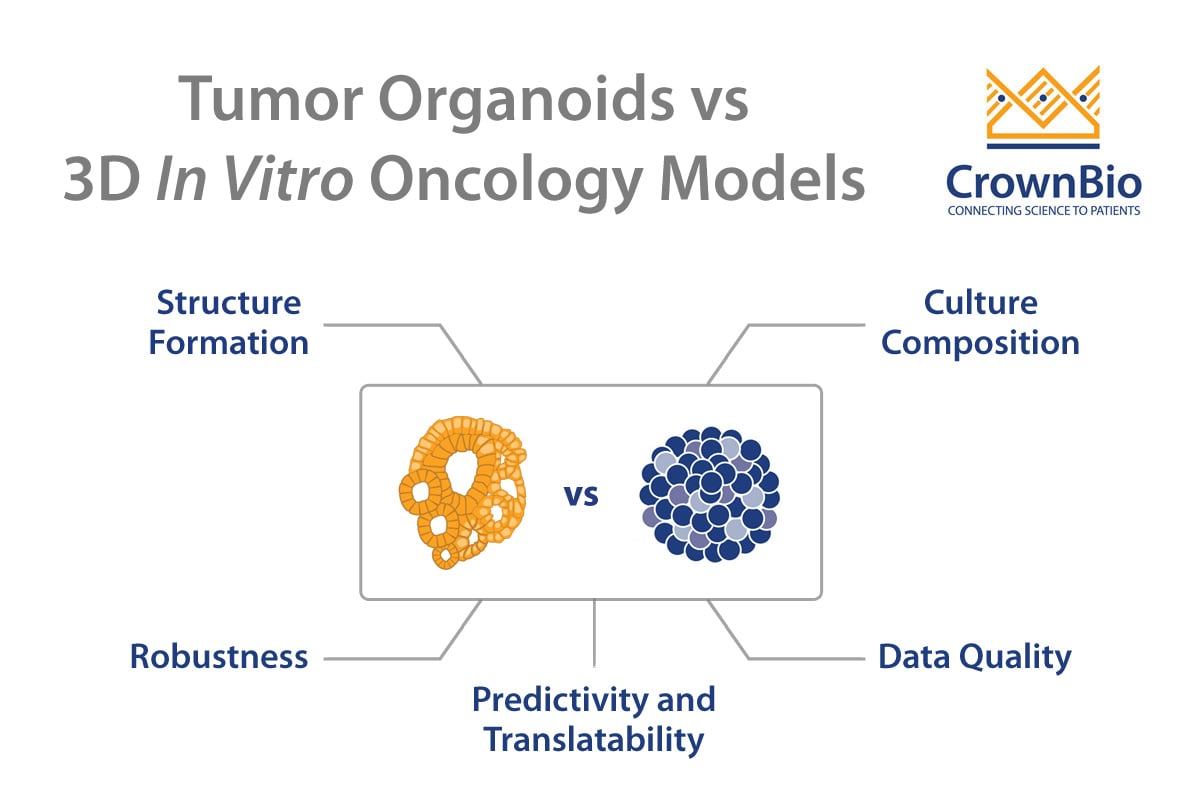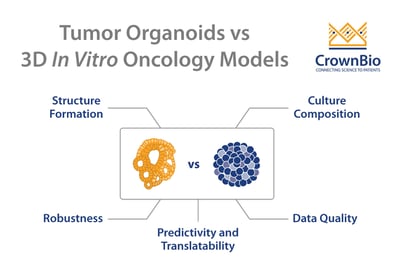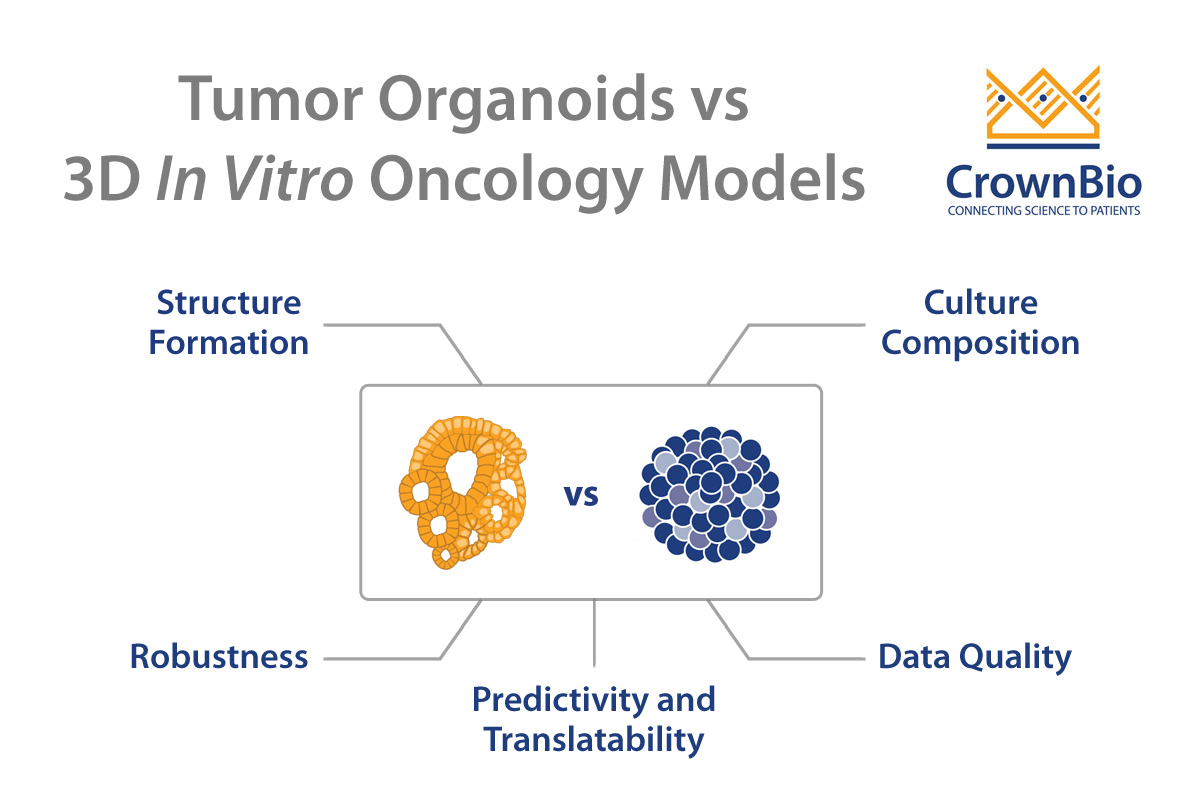Why Choose Tumor Organoids vs Other 3D In Vitro Models for Oncology Drug Development

 Review the key differences between tumor organoids and other 3D in vitro tumor cell cultures, including spheroids, which influences model choice for oncology drug development use.
Review the key differences between tumor organoids and other 3D in vitro tumor cell cultures, including spheroids, which influences model choice for oncology drug development use.
The Move from 2D to 3D, and How to Choose the Right 3D In Vitro System
Historically, oncology research and drug development used conventional 2D in vitro systems, such as cancer cell line monolayers. Now, researchers and drug developers are increasingly adopting 3D cell cultures. This is because 3D tumor models more faithfully recapitulate original tissue architecture which influences a range of features including cell signalling, proliferation, viability, and drug response.
There are various options when it comes to selecting a 3D in vitro oncology system. Determining which one to use largely depends on the biological question(s) being asked such as dissection of disease pathways, investigating mechanisms of action, and predicting patient response. While spheroids have been widely adopted as 3D models, more patient-relevant alternatives such as tumor organoids, have now been developed.
In this post we explore some of the key differences between tumor organoids and other 3D tumor cell cultures, including spheroids, and how this influences model choice for oncology drug development use.
Nature of the Force Driving the Formation of a 3D Structure
Organoid formation is driven by the self-organizing properties of stem cells which self-renew and differentiate in vitro. This gives rise to 3D structures with multiple differentiated and physiologically functional cell lineages.
Conversely, spheroids are formed primarily via cell-to-cell adhesion. Spheroid cells are forced together to assemble in a 3D structure by specific physical/chemical properties of the growing culture.
As a result, when it comes to cancer drug discovery applications, the higher physiological relevance of organoids means that they are more likely to produce data that better translate to in vivo.
Composition of the 3D Culture
Spheroids that are derived from tumor cell lines, commonly referred to as tumorspheres, are typically a monoculture and therefore lack the multicellular identity that exists in an in vivo tumor. Similar to 2D cell lines, tumorspheres are cultured in conditions that select for a high proportion of poorly differentiated cells with high replicative potential which are generally more resilient and more capable of growing in vitro. These characteristics can affect drug response and produce data that poorly translate to the clinic.
In contrast, organoids have a multicellular identity that more faithfully recapitulates the complexity of the corresponding tumor or organ they were derived from. The multicellular identity is formed since organoids are derived from stem cells which in turn differentiate into multiple specialized progenies.
From a cancer drug discovery perspective, the multicellular identity of tumor organoids more closely resemble tumors in vivo, once again significantly improving the patient relevance and translatability of 3D in vitro modelling.
Clinical Predictivity and Translatability
Tumor organoids remain the most predictive in vitro model in terms of clinical response in vivo. Their remarkable clinical predictivity is linked to their recapitulation of key phenotypic (e.g. structural and cellular heterogeneity, including both CSCs and their downstream more-differentiated progeny) and genetic features (e.g., somatic mutations from the tumor) observed in the original tumor. Given their high clinical relevance, tumor organoids are a great platform for drug and biomarker discovery, testing combinations of drugs, and for precision medicine approaches.
In contrast, there have been reports in the literature of changes in response profile in tumorspheres over time which makes them a less robust system compared to organoids. Other types of patient-derived models, such as primary cells, which better preserve parental tumor genetic features and multicellular identity compared to spheroids, can be cultured in 3D. However, they have a very limited culture lifespan because they contain a high proportion of differentiated cells and quickly become senescent, therefore affecting their scalability.
In addition, deriving primary cells from some cancer types remains notoriously challenging and typical culture conditions can select for cells that best withstand the in vitro environment.
Robustness
Tumor organoids provide a highly robust model system for applications such as drug screening, with high reproducibility from one batch to the next. This is due to tumor organoids being developed using HUB protocols, which ensure that the cancer stem cell (CSC) component of the tumor is preserved. This means tumor organoids can be biobanked and resuscitated, and expanded for large scale drug screens all while preserving their genomic, trascriptomic, and morphological features.
With primary cells in 3D, you tend to have a much higher batch-to-batch variation. This is because the cells can’t be expanded to the same extent as organoids, so if large quantities are needed you may have to re-derive the whole culture (therefore introducing variability).
Data Quality
Much like 2D cell lines, which are monocultures of one cell type, organoids are a clean system made up entirely of epithelial cells. This means that the data quality obtained is usually pretty high with a very good signal to noise ratio from classical assay readouts. In addition, organoids can be derived from matched tumor and healthy tissue for better controlled experimental data.
Other 3D primary cell culture data, on the other hand, may be clouded by the lack of stability of the cells in culture. Tumorspheres do provide the benefit of historical data availability for comparison, which is not always available for the relatively new tumor organoids.
Conclusion
Tumor organoids faithfully recapitulate the complexities observed in parental human cancer tissue, and show high patient-relevance and translatability. The underlying nature of tumor organoids also makes them robust and reproducible across a wide variety of applications important for drug discovery and development.
While other 3D cancer cell culture models continue to be relevant for many different applications, it’s important to be aware of the benefits and limitations of different in vitro tumor models to choose the most appropriate for your needs.


